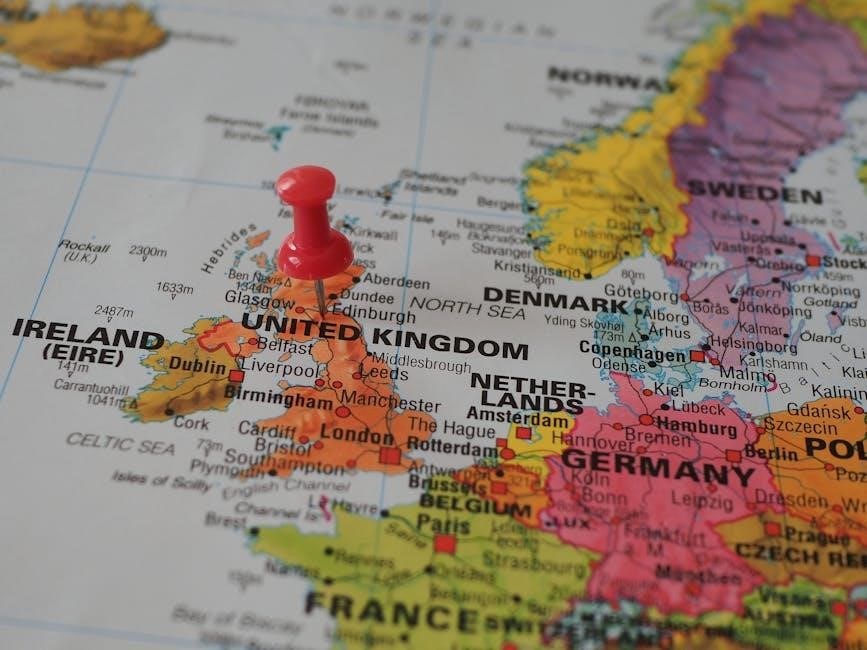Biological evolution refers to the descent of organisms with inherited modifications over generations. This fundamental concept explains how life diversifies and adapts, shaping species through genetic changes and environmental interactions.
1.1 Definition of Evolution
Evolution is the scientifically supported theory that all species of life have developed from a common ancestor through a process of variation, mutation, genetic drift, and natural selection. It describes how organisms change over successive generations, leading to diversity and complexity. Biological evolution encompasses both small-scale changes, such as shifts in allele frequencies within populations, and large-scale changes, such as the emergence of new species. The core idea is that heritable traits are passed from parents to offspring, with environmental pressures influencing which traits become more common. Over time, these changes accumulate, resulting in the rich biodiversity observed today. Evolution is a fundamental concept in biology, explaining how life on Earth has adapted and transformed since its origin. This definition is central to understanding the mechanisms and evidence supporting evolutionary biology, as well as its relevance to modern scientific inquiries and applications.
1.2 Biological Evolution: Descent with Inherited Modification
Evolution is the scientifically supported theory that all species of life have developed from a common ancestor through a process of variation, mutation, genetic drift, and natural selection. It describes how organisms change over successive generations, leading to diversity and complexity. Biological evolution encompasses both small-scale changes, such as shifts in allele frequencies within populations, and large-scale changes, such as the emergence of new species. The core idea is that heritable traits are passed from parents to offspring, with environmental pressures influencing which traits become more common. Over time, these changes accumulate, resulting in the rich biodiversity observed today. Evolution is a fundamental concept in biology, explaining how life on Earth has adapted and transformed since its origin. This definition is central to understanding the mechanisms and evidence supporting evolutionary biology, as well as its relevance to modern scientific inquiries and applications.

Evidence for Evolution
Fossils, DNA, and embryology provide strong evidence for evolution, showing how species change over time. Comparative anatomy and transitional fossils further support evolutionary relationships, demonstrating life’s gradual adaptation and diversification.
2.1 Fossils as Evidence of Evolution
Fossils provide a chronological record of life on Earth, illustrating gradual changes in species over time. Transitional fossils, such as those showing the evolution of whales or birds, demonstrate intermediate forms between ancient and modern organisms.
- Fossil layers reveal the appearance and extinction of species, aligning with evolutionary timelines.
- The presence of vestigial structures in fossils, like dinosaur hips in birds, supports evolutionary relationships.
- Fossil evidence of ancient species, such as dinosaurs, confirms the history of life’s diversification.
- The fossil record shows how environmental changes have driven adaptations in organisms.
These findings align with genetic and anatomical data, reinforcing evolution as a well-supported scientific theory.
2.2 DNA and Genetic Evidence for Evolution
DNA and genetic evidence provide strong support for evolution by revealing similarities and differences among species. Comparisons of DNA sequences show that closely related species share more genetic material, indicating common ancestry.
- Similarities in DNA sequences across species, such as humans and chimpanzees sharing over 98% of their DNA, highlight evolutionary relationships.
- Vestigial genes, like the human gene for producing vitamin C, suggest remnants of ancestral traits.
- Comparative genomics identifies shared genetic mutations, supporting the idea of descent from a common ancestor.
- The presence of transposable elements in similar locations across species further confirms shared evolutionary history.
- Genetic variations within populations and the process of natural selection drive evolutionary changes over time.
These genetic findings align with fossil and anatomical evidence, reinforcing the theory of evolution as a well-supported explanation for life’s diversity.
2.3 Embryology as Evidence for Evolution
Embryology provides significant evidence for evolution by revealing similarities in the early developmental stages of different species. Many organisms exhibit shared embryonic features that disappear or modify as they develop.
- Human embryos, for example, develop gill slits and tailbones early in gestation, similar to fish and other aquatic animals, even though these features disappear before birth.
- Whale embryos show hind limb buds, indicating ancestors once lived on land.
- Bird and reptile embryos share tooth-like structures, despite birds not having teeth as adults.
- Vestigial organs, like the human appendix, are remnants of ancestral traits.
These embryonic similarities suggest a common ancestry, as evolution retains developmental pathways while adapting them to new environments. Such patterns align with evolutionary theory, showing how species diverge while maintaining ancestral traits early in development.
2.4 Comparative Anatomy and Homologous Structures
Comparative anatomy examines the structural similarities and differences among organisms, providing evidence for evolution. Homologous structures, which have the same origin but different functions, highlight shared ancestry.
- The forelimbs of vertebrates, such as human arms, bat wings, and whale flippers, demonstrate homology, showing how a common ancestral structure adapts to different environments.
- Vestigial structures, like the human appendix or pelvic bones in snakes, are remnants of traits that were functional in ancestors but have lost their original purpose.
- Analogous structures, such as bird and butterfly wings, differ in origin but serve similar functions, illustrating convergent evolution.
These anatomical similarities and differences support the idea of descent with modification, a key concept in evolutionary biology. By studying homologous and vestigial structures, scientists infer evolutionary relationships and trace the history of life on Earth.
2.5 The Fossil Record and Transitional Fossils
The fossil record provides a chronological archive of life on Earth, documenting the history of species and their evolutionary changes over time. Transitional fossils, such as Tiktaalik (between fish and amphibians) and Archaeopteryx (between dinosaurs and birds), exhibit a mix of ancestral and derived traits, offering direct evidence of evolutionary transitions.
- These fossils show gradual modifications in structures, such as the evolution of limbs or feathers, supporting the idea of descent with modification.
- The presence of vestigial traits in fossils, like whale pelvis bones, further aligns with evolutionary theory, indicating traits retained from ancestors.
- The fossil record, while incomplete due to rare conditions needed for fossilization, still provides substantial evidence of evolutionary relationships and timelines.
Transitional fossils bridge gaps between major groups, illustrating how species evolve into new forms over millions of years. This evidence is central to understanding the patterns and processes of evolutionary history.

Mechanisms of Evolution
Evolution occurs through natural selection, genetic drift, mutation, gene flow, and sexual selection. These processes drive changes in allele frequencies, shaping biodiversity and adaptation over generations.
3.1 Natural Selection
Natural selection is a fundamental mechanism of evolution, proposed by Charles Darwin, where organisms with favorable traits are more likely to survive and reproduce. This process drives adaptation, as beneficial characteristics become more common in populations over generations. It relies on three key components: variation among individuals, heritability of traits, and differential reproduction based on environmental pressures. Over time, this leads to the accumulation of adaptations, enabling species to better fit their ecological niches. Natural selection is supported by evidence from fossil records, comparative anatomy, and genetic studies. It is a cornerstone of evolutionary biology, explaining how life diversifies and thrives in changing environments. Understanding natural selection is crucial for grasping how species evolve and adapt, making it a central topic in any study guide on evolution.
3.2 Genetic Drift
Genetic drift is a key mechanism of evolution that refers to random changes in allele frequencies within a population. Unlike natural selection, which is driven by environmental pressures, genetic drift is non-directional and can lead to either the loss or fixation of alleles. It is particularly influential in small populations, where chance events, such as genetic mutations or random mating, can significantly alter the genetic makeup; Over time, this can result in population divergence and even speciation. Genetic drift, while often seen as a neutral force, interacts with other evolutionary processes, such as mutation and gene flow, shaping the genetic diversity of species. Understanding genetic drift is essential for comprehending the stochastic aspects of evolution and how populations evolve over generations. It is a critical component of modern evolutionary theory, emphasizing the role of chance in shaping life’s diversity.
3.3 Mutation
Mutation is a fundamental driver of genetic variation and a key mechanism in evolution. It involves random changes in the DNA sequence of an organism, creating new alleles that can be passed on to offspring. Mutations can occur due to errors during DNA replication or exposure to environmental factors like radiation or chemicals. While most mutations are neutral, some can confer advantages or disadvantages, influencing an organism’s fitness. Beneficial mutations may increase in frequency through natural selection, whereas harmful ones are often selected against. Mutation rates vary across species and tissues, but they consistently serve as the raw material for evolutionary change. Without mutation, populations would lack the genetic diversity necessary for adaptation and survival in changing environments. Thus, mutation is essential for the dynamic and ongoing process of evolution, providing the genetic foundation upon which other evolutionary forces act.
3.4 Gene Flow
Gene flow is the transfer of genetic material between populations, leading to changes in allele frequencies and reducing genetic differences between them. It occurs when individuals migrate and interbreed with members of another population, introducing new alleles. This mechanism increases genetic diversity within a population and can lead to the homogenization of gene pools across populations. Gene flow is a critical evolutionary force that counteracts the effects of genetic drift and natural selection by maintaining genetic connectivity. It also plays a role in the spread of advantageous traits, enhancing a population’s adaptability. However, excessive gene flow can erase unique adaptations in isolated populations. Understanding gene flow is essential for studying how species maintain genetic cohesion and adapt to environmental changes. It highlights the dynamic nature of genetic exchange in shaping the evolutionary trajectory of populations.
3.5 Sexual Selection
Sexual selection is a mechanism driving evolution through mate choice and competition for reproductive success; It operates when individuals with certain traits are more attractive to mates or better at securing them. These traits, often exaggerated, enhance an organism’s ability to acquire a mate, even if they reduce survival chances. Sexual selection can lead to rapid evolutionary changes, creating distinct differences between sexes. For example, peacock tails or deer antlers are outcomes of sexual selection. It acts alongside natural selection, sometimes conflicting with it, as traits beneficial for mating may not enhance survival. This process is crucial in explaining the diversity of mating behaviors and morphological features in many species. Sexual selection highlights how reproductive success shapes the evolution of specific traits, emphasizing the role of social and reproductive interactions in evolutionary outcomes. Understanding this mechanism is vital for grasping how species develop unique characteristics linked to mating and reproduction.

History of Evolutionary Thought
Evolutionary thought traces back to ancient philosophers and scientists, evolving through Enlightenment ideas and 19th-century discoveries. It laid the groundwork for modern theories, shaping our understanding of life’s diversity and change over time.
4.1 Charles Darwin and the Theory of Evolution by Natural Selection
Charles Darwin revolutionized biology with his groundbreaking theory of evolution by natural selection. His seminal work, On the Origin of Species (1859), introduced the concept that species evolve over time through a process of descent with modification. Darwin’s observations during his voyage on the HMS Beagle provided crucial evidence for his theory, particularly the diversity of species in the Galápagos Islands. He proposed that individuals with favorable traits are more likely to survive and reproduce, passing those traits to their offspring. This mechanism, known as natural selection, drives the adaptation and diversification of life. Darwin’s ideas fundamentally changed scientific understanding, offering a coherent explanation for the complexity and variety of life on Earth. His work laid the foundation for modern evolutionary biology, influencing fields such as genetics, ecology, and paleontology.
4.2 Modern Synthesis and Neo-Darwinism
The Modern Synthesis, also known as Neo-Darwinism, emerged in the mid-20th century as a fusion of Darwin’s theory of natural selection with modern genetics. This framework integrated the ideas of genetic inheritance, population dynamics, and fossil records to create a comprehensive theory of evolution. Key contributors included Ronald Fisher, J.B.S. Haldane, and Theodosius Dobzhansky, who bridged the gap between Darwinian concepts and Mendelian genetics. The Modern Synthesis emphasized that evolution occurs at the level of populations, with changes in allele frequencies driving species transformation. It also incorporated mechanisms such as mutation, genetic drift, and gene flow alongside natural selection. This synthesis provided a robust explanation for the diversity of life, aligning with molecular biology advancements. Neo-Darwinism solidified evolution as a predictable, scientific process, offering a unified framework for understanding life’s history and complexity.

Evolutionary Processes
Evolutionary processes describe the mechanisms driving species transformation, including natural selection, genetic drift, mutation, and gene flow, leading to genetic changes, adaptation, and new species emergence. These processes collectively shape biodiversity and life’s complexity.
5.1 Speciation and the Formation of New Species
Speciation is the process by which new species emerge from existing ones, often due to reproductive isolation. This isolation can occur through geographical barriers, genetic mutations, or environmental pressures, preventing interbreeding and gene flow.
Over time, divergent natural selection pressures lead to distinct adaptations, reinforcing reproductive isolation. Key mechanisms include allopatric speciation (geographical separation) and sympatric speciation (no physical barrier but genetic divergence).
The formation of new species is marked by the inability to produce fertile offspring with the parent species. This process is central to biodiversity, explaining how life on Earth has diversified into millions of distinct species over millennia.
5.2 Adaptation and Its Role in Evolution
Adaptation is the process by which organisms develop traits that enhance their survival and reproductive success in specific environments. It is a cornerstone of evolution, enabling species to thrive amidst changing conditions.
Adaptations arise through natural selection, where beneficial genetic variations become more common in a population over generations. For example, the peppered moth evolved darker wings in polluted areas, while bacteria developed resistance to antibiotics.
These traits improve fitness, increasing an organism’s ability to compete, evade predators, or exploit resources. Adaptation drives evolutionary change, leading to biodiversity and the specialization of species in their ecological niches.
While adaptations are advantageous in specific contexts, they may become detrimental if environmental conditions shift. Thus, adaptation is a dynamic and essential mechanism in the evolutionary process, shaping life’s diversity and resilience.
Study Guide Questions
Key questions include: How is DNA used as evidence for evolution? What led to Darwin’s conclusions? Compare sexual and natural selection. Define evolution and its mechanisms. Explain adaptation’s role.
6.1 How Is DNA Used as Evidence for Evolution?
DNA comparisons reveal genetic relationships between species, indicating common ancestry. Similarities in coding and non-coding regions suggest shared evolutionary histories. Mutations and natural selection act on DNA, driving evolutionary change over time. For example, pseudogenes and vestigial DNA sequences are remnants of ancestral genes, supporting evolution. Genetic data aligns with fossil records and comparative anatomy, confirming evolutionary links. DNA sequences from different species show gradual changes, reflecting their divergence over millions of years. These molecular similarities and differences provide strong evidence for evolutionary relationships, as predicted by the theory of evolution.
6.2 What Are the Observations That Led to Darwin’s Conclusions?
Darwin’s observations during his voyage on the HMS Beagle laid the foundation for his theory of evolution. He noted the diversity of species across different environments and how they adapted to their specific habitats. For instance, he observed distinct species of finches on the Galapagos Islands, each with unique beak shapes suited to their diet. He also saw that similar species existed on different continents but were better adapted to their local environments. Additionally, Darwin observed the existence of vestigial structures, such as the appendix in humans, which he inferred were remnants of once-functional features in ancestors. He also considered the fossil record, which showed a progression of life forms over time. These observations led Darwin to propose that species change over generations through a process of natural selection, where advantageous traits are passed on, driving evolutionary change.
6.3 Compare and Contrast Sexual Selection and Natural Selection
Sexual selection and natural selection are both mechanisms driving evolutionary change, but they operate through different means. Natural selection focuses on traits that enhance survival and reproductive success in a given environment, such as camouflage or resistance to predators. It acts on all individuals, regardless of gender, and leads to adaptation to environmental challenges. In contrast, sexual selection specifically involves traits that improve an organism’s ability to attract mates or compete for them, often resulting in exaggerated features like peacock tails. While natural selection can lead to increased fitness for both sexes, sexual selection often creates differences between males and females, driving sexual dimorphism. Both processes increase the likelihood of passing genes to the next generation, but natural selection emphasizes survival, whereas sexual selection emphasizes mating success. Despite their differences, both are integral to the diversity of life observed in nature.

